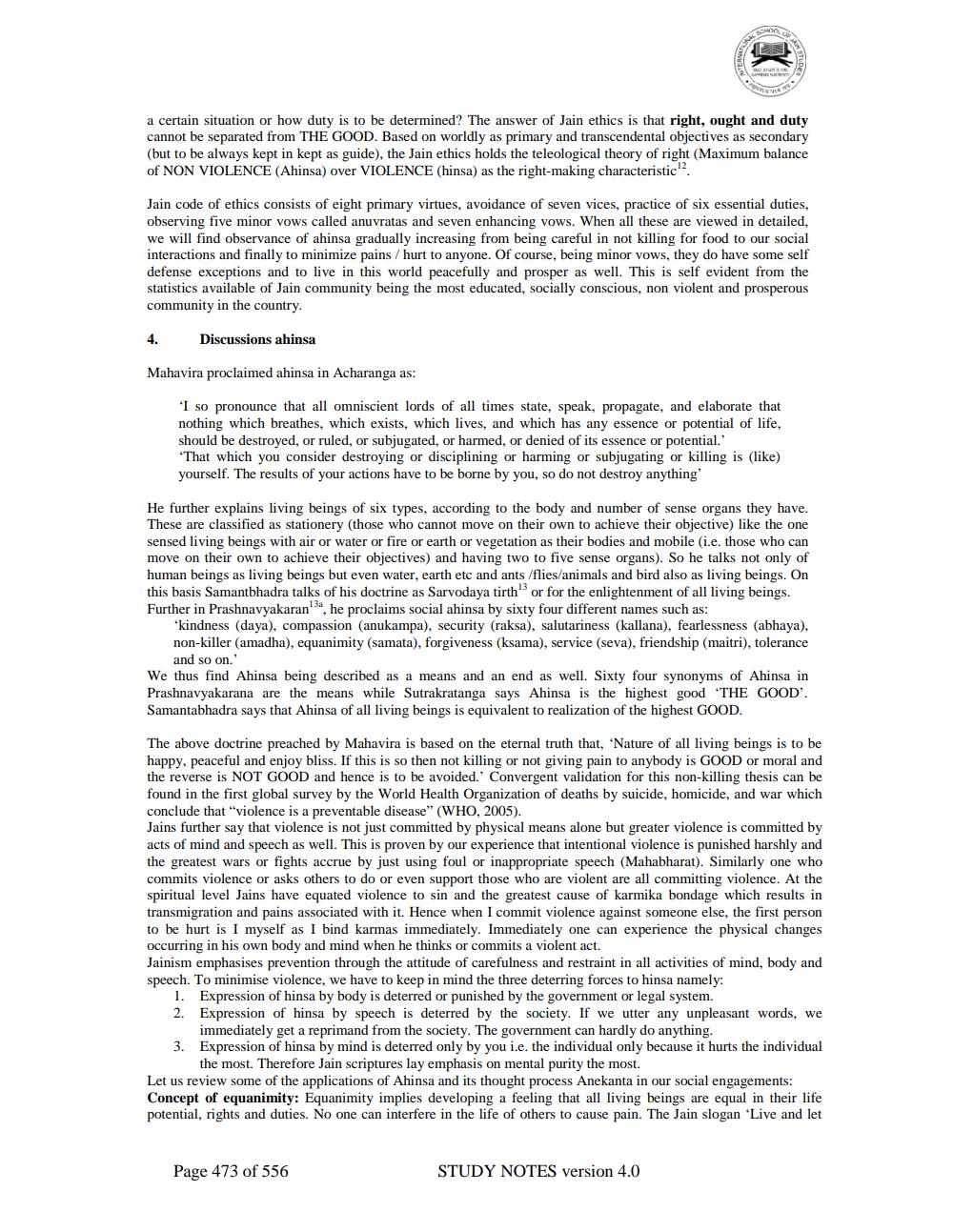________________
a certain situation or how duty is to be determined? The answer of Jain ethics is that right, ought and duty cannot be separated from THE GOOD. Based on worldly as primary and transcendental objectives as secondary (but to be always kept in kept as guide), the Jain ethics holds the teleological theory of right (Maximum balance of NON VIOLENCE (Ahinsa) over VIOLENCE (hinsa) as the right-making characteristic'
Jain code of ethics consists of eight primary virtues, avoidance of seven vices, practice of six essential duties, observing five minor vows called anuvratas and seven enhancing vows. When all these are viewed in detailed, we will find observance of ahinsa gradually increasing from being careful in not killing for food to our social interactions and finally to minimize pains / hurt to anyone. Of course, being minor vows, they do have some self defense exceptions and to live in this world peacefully and prosper as well. This is self evident from the statistics available of Jain community being the most educated, socially conscious, non violent and prosperous community in the country.
Discussions ahinsa
Mahavira proclaimed ahinsa in Acharanga as:
'I so pronounce that all omniscient lords of all times state, speak, propagate, and elaborate that nothing which breathes, which exists, which lives, and which has any essence or potential of life, should be destroyed, or ruled, or subjugated, or harmed, or denied of its essence or potential.' "That which you consider destroying or disciplining or harming or subjugating or killing is (like) yourself. The results of your actions have to be borne by you, so do not destroy anything
He further explains living beings of six types, according to the body and number of sense organs they have. These are classified as stationery (those who cannot move on their own to achieve their objective) like the one sensed living beings with air or water or fire or earth or vegetation as their bodies and mobile (i.e. those who can move on their own to achieve their objectives) and having two to five sense organs). So he talks not only of human beings as living beings but even water, earth etc and ants/flies/animals and bird also as living beings. On this basis Samantbhadra talks of his doctrine as Sarvodaya tirth" or for the enlightenment of all living beings. Further in Prashnavyakaran', he proclaims social ahinsa by sixty four different names such as:
"kindness (daya), compassion (anukampa), security (raksa), salutariness (kallana), fearlessness (abhaya). non-killer (amadha), equanimity (samata), forgiveness (ksama), service (seva), friendship (maitri), tolerance
and so on. We thus find Ahinsa being described as a means and an end as well. Sixty four synonyms of Ahinsa in Prashnavyakarana are the means while Sutrakratanga says Ahinsa is the highest good "THE GOOD'. Samantabhadra says that Ahinsa of all living beings is equivalent to realization of the highest GOOD.
The above doctrine preached by Mahavira is based on the eternal truth that, "Nature of all living beings is to be happy, peaceful and enjoy bliss. If this is so then not killing or not giving pain to anybody is GOOD or moral and the reverse is NOT GOOD and hence is to be avoided.' Convergent validation for this non-killing thesis can be found in the first global survey by the World Health Organization of deaths by suicide, homicide, and war which conclude that "violence is a preventable disease" (WHO, 2005). Jains further say that violence is not just committed by physical means alone but greater violence is committed by acts of mind and speech as well. This is proven by our experience that intentional violence is punished harshly and the greatest wars or fights accrue by just using foul or inappropriate speech (Mahabharat). Similarly one who commits violence or asks others to do or even support those who are violent are all committing violence. At the spiritual level Jains have equated violence to sin and the greatest cause of karmika bondage which results in transmigration and pains associated with it. Hence when I commit violence against someone else, the first person to be hurt is I myself as I bind karmas immediately. Immediately one can experience the physical changes occurring in his own body and mind when he thinks or commits a violent act. Jainism emphasises prevention through the attitude of carefulness and restraint in all activities of mind, body and speech. To minimise violence, we have to keep in mind the three deterring forces to hinsa namely:
1. Expression of hinsa by body is deterred or punished by the government or legal system. 2. Expression of hinsa by speech is deterred by the society. If we utter any unpleasant words, we
immediately get a reprimand from the society. The government can hardly do anything. 3. Expression of hinsa by mind is deterred only by you i.e. the individual only because it hurts the individual
the most. Therefore Jain scriptures lay emphasis on mental purity the most. Let us review some of the applications of Ahinsa and its thought process Anekanta in our social engagements: Concept of equanimity: Equanimity implies developing a feeling that all living beings are equal in their life potential, rights and duties. No one can interfere in the life of others to cause pain. The Jain slogan 'Live and let
Page 473 of 556
STUDY NOTES version 4.0




